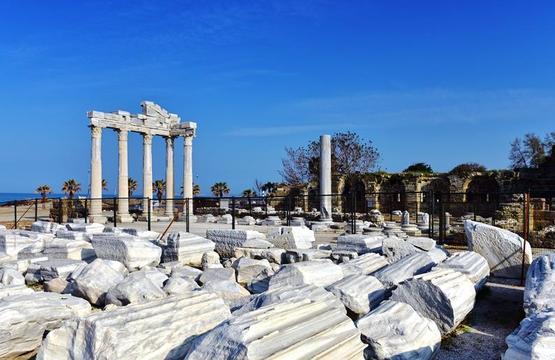Side

This article is about the town of Side on the Mediterranean coast of Turkey. For the town of ancient Caria, see Side (Caria). For the town of ancient Pontus, see Side (Pontus).
Side is a city on the southern Mediterranean coast of Turkey. It includes the modern resort town and the ruins of the ancient city of Side, one of the best-known classical sites in the country. It lies near Manavgat and the village of Selimiye, 78 km from Antalya in the province of Antalya.[1]
It is located on the eastern part of the Pamphylian coast, which lies about 20 km east of the mouth of the Eurymedon River. Today, as in antiquity, the ancient city is situated on a small north-south peninsula about 1 km long and 400 m across.
History
Pseudo-Scylax,[2] Strabo and Arrian record that Side was founded by Greek settlers from Cyme in Aeolis, a region of western Anatolia. This most likely occurred in the 7th century BC. Its tutelary deity was Athena, whose head adorned its coinage.
Dating from the tenth century BC, its coinage bore the head of Athena, the patroness of the city, with a legend. Its people, a piratical horde, quickly forgot their own language to adopt that of the aborigines.
Possessing a good harbour for small-craft boats, Side's natural geography made it one of the most important places in Pamphylia and one of the most important trade centres in the region. According to Arrian, when settlers from Cyme came to Side, they could not understand the dialect. After a short while, the influence of this indigenous tongue was so great that the newcomers forgot their native Greek and started using the language of Side. Excavations have revealed several inscriptions written in this language. The inscriptions, dating from the 3rd and 2nd centuries BC, remain undeciphered, but testify that the local language was still in use several centuries after colonisation. Another object found in the excavations at Side, a basalt column base from the 7th century BC and attributable to the Neo-Hittites, provides further evidence of the site's early history. The name Side may be Anatolian in origin, but it means pomegranate in Greek.[citation needed]
Next to no information exists concerning Side under Lydian and Persian sovereignty.
Alexander the Great
Alexander the Great occupied Side without a struggle in 333 BC. Alexander left only a single garrison behind to occupy the city. This occupation, in turn, introduced the people of Side to Hellenistic culture, which flourished from the 4th to the 1st century BC. After Alexander's death, Side fell under the control of one of Alexander's generals, Ptolemy I Soter, who declared himself king of Egypt in 305 BC. The Ptolemaic dynasty controlled Side until it was captured by the Seleucid Empire in the 2nd century BC. Yet, despite these occupations, Side managed to preserve some autonomy, grew prosperous, and became an important cultural centre.
Walls of the ancient theatre of Side
In 190 BC a fleet from the Greek island city-state of Rhodes, supported by Rome and Pergamum, defeated the Seleucid King Antiochus the Great's fleet, which was under the command of the fugitive Carthaginian general Hannibal. The defeat of Hannibal and Antiochus the Great meant that Side freed itself from the overlord-ship of the Seleucid Empire. The Treaty of Apamea (188 BC) forced Antiochus to abandon all European territories and to cede all of Asia Minor north of the Taurus Mountains to Pergamum. However, the dominion of Pergamum only reached de facto as far as Perga, leaving Eastern Pamphylia in a state of uncertain freedom. This led Attalus II Philadelphus to construct a new harbour in the city of Attalia (the present Antalya), although Side already possessed an important harbour of its own. Between 188 and 36 BC Side minted its own money, tetradrachms showing Nike and a laurel wreath (the sign of victory).
In the 1st century BC, Side reached a peak when the Cilician pirates established their chief naval base and a centre for their slave-trade.
Romans
The consul Servilius Vatia defeated these brigands in 78 BC and later the Roman general Pompey in 67 BC, bringing Side under the control of Rome and beginning its second period of ascendancy, when it established and maintained a good working relationship with the Roman Empire.[3]
Emperor Augustus reformed the state administration and placed Pamphylia and Side in the Roman province of Galatia in 25 BC, after the short reign of Amyntas of Galatia between 36 and 25 BC. Side began another prosperous period as a commercial centre in Asia Minor through its trade in olive oil. Its population grew to 60,000 inhabitants. This period would last well into the 3rd century AD. Side also established itself as a slave-trading centre in the Mediterranean. Its large commercial fleet engaged in acts of piracy, while wealthy merchants paid for such tributes as public works, monuments, and competitions as well as the games and gladiator fights. Most of the extant ruins at Side date from this period of prosperity.
One of the maps (portolani) of Piri Reis, taken from the Kitab-i Bahriye, which Piri produced in several editions, supplementing in 1520, but integrating it into subsequent editions.
Side was the home of Eustathius of Antioch, of the philosopher Troilus, of the fifth-century ecclesiastical writer Philip; of the famous lawyer Tribonian.[4]
Decline
Side began a steady decline from the 4th century on. Even defensive walls could not stop successive invasions of highlanders from the Taurus Mountains. During the 5th and 6th centuries, Side experienced a revival, and became the seat of the Bishopric of Eastern Pamphylia. Arab fleets, nevertheless, raided and burned Side during the 7th century, contributing to its decline. The combination of earthquakes, Christian zealots and Arab raids, left the site abandoned by the 10th century, its citizens having emigrated to nearby Attalia.[3]
In the 12th century, Side temporarily established itself once more as a large city. An inscription found on the site of the former ancient city shows a considerable Jewish population in early Byzantine times. However, Side was abandoned again after being sacked. Its population moved to Attalia, and Side became known as Eski Adalia 'Old Antalya' and was buried.
Ecclesiastical history
As capital of the Roman province of Pamphylia Prima, Side was ecclesiastically the metropolitan see. The earliest known bishop was Epidaurus, presiding at the Synod of Ancyra, 314. Others are John, fourth century; Eustathius, 381; Amphilochius, 426-458, who played an important part in the history of the time; Conon, 536; Peter, 553; John, 680-692; Mark, 879; Theodore, 1027-1028; Anthimus, present at the synod held at Constantinople in 1054; John, then counsellor to the Emperor Michael VII Ducas, presided at a council on the worship of images, 1082; Theodosius and his successor Nicetas, twelfth century.
John, present at a synod at Constantinople in 1156. The Notitiae Episcopatuum continued to mention Side as a metropolis of Pamphylia until the thirteenth century. It does not appear in the "Notitia" of Andronicus III. In 1397 the diocese was united with that of Attalia; in 1400 the Metropolitan of Perge and Attalia was at the same time the administrator of Side.[5][citation needed] No longer a residential see, Side is today included in the Catholic Church's list of titular sees.[6]


